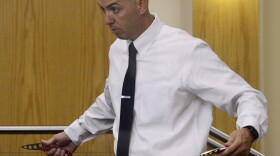Two former Albuquerque police officers are facing murder charges for what could be the first time here. The effectiveness of the SWAT team in dangerous situations has come into play during the trial, and police who were there the day James Boyd was shot in 2014 have been testifying in court. It’s the first time the public has heard directly from many of these officers.
The police went out that Sunday because a neighbor had called saying a homeless man was camping in the Foothills of the Sandia Mountains. The standoff lasted hours, and it became apparent from the things the camper was saying that he had a mental illness.
James Boyd was eventually shot and killed by police. And in the days after, people were asking: Where were the officers specially trained to talk to people in crisis?
It turns out an Albuquerque Police Department officer who was known for doing just that was called to the scene and spent more than an hour trying to de-escalate the situation. Officer Mikal Monette said he didn’t think Boyd understood why police were there in the first place. "He didn’t think he was causing any harm," he said.
Monette testified that he’d spoken to people with mental illness hundreds of times. Boyd took his folding knives out of his pockets, but he said he talked him into putting them away and keeping his hands visible.
"Just being persistent," Monette explained. "Kinda just talking to him and saying, 'Hey, you know, you don’t need to have your weapons out. Can you put them away? Can you put them down?' "
Monette said he could see Boyd’s emotions spike and plummet as he was talking to him. And he testified that according to APD procedure, it’s OK to let people in crisis vent their emotions, to find out what’s bothering them, and to avoid topics that set them off. But Boyd was scared, Monette said.
"I believe he was afraid of us having the weapons out, having the weapons pointed at him," he said. "He was afraid of getting shot or having some use of force used on him."
Even though it’s protocol for the officer who established rapport to keep talking to a person who’s in crisis, Monette said a sergeant pulled him away from Boyd and told him to help divert people away from the standoff instead.
From his new post, he could hear the shots that killed Boyd. "I’d heard the flash-bang and then heard the shots," Monette said. "You could just kind of get a sense of what’s going on from the sound."
Jason Carpenter, the sergeant who sent Monette down the mountain, also took the stand in the trial. He was making the calls on how to deal with Boyd that afternoon—at first. "He was not safe for the community," he said.
Carpenter testified that they weren’t having a lot of success with Boyd. "If we just packed up and walked away, we wouldn’t be doing our job in protecting the community," he said. "I was also thinking at very least, he may need a mental health evaluation."
Carpenter called for a Taser shotgun, for someone from the gang unit who could operate one to come to the scene. That’s when one of the defendants, Keith Sandy, arrived. It was his day off and he wasn’t on the gang unit, but he responded anyway.
"You know, every officer and supervisor, you want to resolve it. You do. So you’re trying, you’re trying, you’re trying," Carpenter said. "And then when there’s—for me at the time—you know, there’s no resolve, it’s like, you can’t predict the future. You’re not sure what’s going to happen."
And even though Carpenter told SWAT officers that everything was under control, they showed up, anyway.
When the Department of Justice released the results of its yearslong investigation into Albuquerque police it called out SWAT overall for a lack of discipline and control that led to unreasonable deadly force. The feds said SWAT failed to help during dangerous situations, and that bad on-scene oversight was part of the problem.
James Fox was the sergeant of the SWAT team during the time period the DOJ was investigating APD’s high number of shootings. Fox said on the stand he was worried about the situation with Boyd that day, about the terrain and coming darkness, and that’s why he went to the scene.
"I knew that it was a Sunday afternoon, and I knew on Sunday afternoons with nice weather, there were going to be many people enjoying the trails up and down around that area," Fox said. "So I was concerned."
Fox sent SWAT officer Dominique Perez, the second defendant, up the hill to provide cover for other officers. Fox said on the stand he regrets that decision, that Perez was a measured and dependable officer with no citizen complaints in his career.
But defense attorney Luis Robles asked Sgt. Fox to explain the wisdom of his decision.
"And knowing what you know today, you would agree with me that despite all of this, you made the right decision to pick the right officer to do the job?" Robles asked.
"Yes, if I had to to do it all over again, I would have to call him again," Fox said.
More police officers are expected to testify this week during the ongoing trial, including Sandy and Perez, who are charged with second-degree murder and facing up to 15 years in prison.







